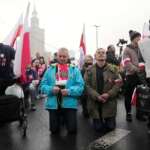A Closer Look at Poland
Poland Flag

Poland Formation Date
Poland's formation date is November 11, 1918.
Poland Capital Name
Warsaw
Poland Neighbours
Exploring Poland
Poland: A Rich Tapestry of History, Culture, and Beauty
Located in Central Europe, Poland is a country steeped in history, culture, and natural beauty. It is bordered by Germany to the west, the Czech Republic and Slovakia to the south, Ukraine and Belarus to the east, and the Baltic Sea and Russia's Kaliningrad Oblast to the north. With a population of over 38 million people, Poland is the 9th most populous country in Europe. Its capital city, Warsaw, is a bustling metropolis that perfectly encapsulates the country's blend of old-world charm and modernity.
Key Takeaways:
- Poland is located in Central Europe and shares borders with Germany, Czech Republic, Slovakia, Ukraine, Belarus, and Russia.
- The country has a population of over 38 million people.
- Warsaw is the capital city of Poland.
Geography:
Poland's geography is diverse and includes mountains, forests, lakes, rivers, and coastlines. The Carpathian Mountains run along the southern border of Poland, while the Tatra Mountains are located in the south-central part of the country. The northern part of Poland is dominated by lowlands and plains. The country also has over 9,300 lakes, including the famous Masurian Lake District. Its longest river is the Vistula River, which flows through several major cities including Warsaw and Krakow.
Poland is rich in natural resources such as coal, copper, silver, lead, and natural gas. It also has fertile soil for agriculture, with crops like potatoes, wheat, and rye being major exports. The climate in Poland is temperate with cold winters and mild summers. The country experiences all four seasons, with heavy snowfall in the winter and warm temperatures in the summer.
Origin and History:
The history of Poland dates back to ancient civilizations, with evidence of human settlements dating back to 400,000 BC. In the 10th century, Poland became a kingdom and was ruled by various dynasties until the late 18th century when it was partitioned by neighboring countries. After World War I, Poland regained its independence and became a republic. However, it was invaded by Nazi Germany during World War II, resulting in the death of millions of Polish citizens. After the war, Poland became a communist state under Soviet influence until the fall of communism in 1989.
Government and Politics:
Poland is a parliamentary republic with a multi-party system. The president is the head of state, while the prime minister is the head of government. The country is divided into 16 administrative regions called voivodeships, each with its own local government. Poland is a member of the European Union and NATO and maintains close relationships with its neighboring countries.
Commerce and Economy:
Poland has a diverse economy with major sectors including manufacturing, agriculture, and services. Its main trading partners are Germany, Russia, China, and the United Kingdom. The currency used in Poland is the Polish złoty (PLN), which is one of the strongest currencies in Central Europe.
Demographics:
The population of Poland is primarily ethnically Polish (96%) with small minority groups such as Ukrainians, Germans, and Belarusians. The median age in Poland is 41 years old, with a slightly higher percentage of females than males. The country has a high literacy rate of 99.8%, and education is highly valued in Polish society.
Culture:
Polish culture is a blend of influences from its neighboring countries, as well as its own unique traditions. The country has a rich history of art, music, and literature, with famous artists such as Jan Matejko and Fryderyk Chopin. Traditional Polish festivals and holidays are celebrated throughout the year, including Easter, Christmas, and the famous Wianki festival in Krakow.
Languages and Religion:
The official language of Poland is Polish, which is spoken by over 97% of the population. There are also regional dialects spoken in different parts of the country. The majority of Poles (87%) identify as Roman Catholic, with other religions such as Orthodox Christianity, Protestantism, and Judaism also present in the country.
Education and Healthcare Systems:
Education is highly valued in Poland, with a strong emphasis on academic achievement. The country has a well-developed education system with over 400 universities and colleges. The literacy rate in Poland is one of the highest in the world at 99.8%. The healthcare system in Poland is also well-developed, with universal healthcare coverage for all citizens.
Sports and Recreation:
Sports are an important part of Polish culture, with football (soccer) being the most popular sport. Other popular sports include volleyball, basketball, and ice hockey. Poland has also produced many successful athletes in various sports, including Olympic medalists.
Tourism:
Poland has a rich cultural heritage and natural beauty, making it a popular tourist destination. Some of the must-visit attractions include the historic Old Town in Warsaw, the stunning Wieliczka Salt Mine, and the beautiful city of Krakow. The country also has a well-developed tourism infrastructure, with a variety of accommodation options, transportation, and activities for visitors to enjoy.
Travel Information for Foreign Visitors:
Foreign visitors to Poland may require a visa depending on their country of origin. It is recommended to check with the nearest Polish embassy or consulate for specific visa requirements. The country has a low crime rate, but visitors should still exercise caution and be aware of their surroundings. The official currency is the Polish złoty (PLN), and most establishments accept credit cards. Tipping in restaurants is customary, with 10-15% being the standard. The official language is Polish, but English is widely spoken in major cities and tourist areas.
Quotes:
"Poland has not yet perished, so long as we still live." - Polish national anthem
"The fate of Poland has often made it a battleground between its neighbors." - Norman Davies
Summary and Future Developments:
Poland is a country with a rich history, diverse culture, and stunning landscapes. Its economy continues to grow, and the country has become an important player in international politics. With its strong education system and focus on innovation, Poland is poised for continued development and success in the future.
As Poland continues to open up to the world, it will undoubtedly attract more visitors who will be captivated by its charm and beauty. With its mix of old-world charm and modernity, Poland offers a unique travel experience that will leave a lasting impression on anyone who visits.
Sources:
Poland Highest Point Name
The highest point in Poland is located in the Tatras, in the south of the country. It is known as Rysy and it has a peak elevation of 2,499 meters (8,199 feet) above sea level.
Poland Capital Longitude
21.0122° E
Poland Capital Latitude
52.2319° N
Poland Official Languages
Polish
Poland Ethnic Groups
The ethnic composition of Poland is dominated by Polish, the most populous of all the ethnic groups. According to the Central Statistical Office of Poland, Poles make up 96.7% of the population. Other minority groups in Poland are Belarussians, Germans, Ukrainians, Lithuanians, Russians, Czechs, Slovaks, Jews, Romani, and other ethnic nationalities. Jews constitute the majority of Poland's non-Polish demography. Belarussians mainly inhabit the southeastern region of Poland. German minorities concentrated in the Opole region and Silesia, while Ukrainians are spread throughout the country, in particular Podlasie and Lesser Poland. Lithuanians mainly inhabit the Vilnius region and Lublin, while Romanis also inhabit certain areas located on both sides of the Polish-Ukrainian border. Czechs and Slovaks are found primarily in the south-west of Poland near the Czech Republic.
Poland Religions
The predominant religion in Poland is Christianity, with Roman Catholicism being the largest denomination. Around 87.2% of the population identify as Roman Catholic, followed by 1.3% who identify as members of the Polish Orthodox Church. Other religions practiced in Poland include Islam, Lutheranism, Presbyterianism, and Judaism. Although the Constitution of Poland protects the freedom of religion, the country does not recognize any religion as being the official one. In the 2000s, statistics showed that almost 81% of Poles declared themselves as religious and over 40% indicated that they attend Mass on a regular basis. Despite there being a large percentage of Catholics in the country, atheism is becoming increasingly popular, especially among the younger demographic. In addition, many Poles, especially in the east, practice folk religious beliefs alongside traditional Christian beliefs.
Poland Total Area
The total area of Poland is 312,679 square kilometers (120,726 sq mi).
Poland Land Area
The total land area of Poland is 312,685 square kilometers (120,728 square miles).
Poland Water Area
Poland has a total water area of 810,000 hectare (2,005,727 acres). This includes all permanent and temporary inland water bodies such as perennial rivers and streams, lakes, reservoirs, oxbow lakes, small ponds, and other small water bodies including artificial ponds and small canals.
Poland Total Population
According to the World Bank, the estimated total population of Poland in 2020 is 37,845,554 people.
Poland Currency Name
The currency of Poland is the Polish Złoty (PLN).
Poland Currency Code
The currency code for Poland is PLN.
Poland Currency Symbol
The country currency symbol for Poland is PLN (złoty).
Poland Time Zones
- Standard Time: UTC+01:00
- Daylight Saving Time: UTC+02:00
Poland's standard time zone is Central European Time (CET), which is UTC+1. Daylight saving time, Central European Summer Time (CEST), is UTC+2 and begins on the last Sunday in March at 01:00 CET, when clocks are moved forward one hour, and ends on the last Sunday in October at 01:00 CEST, when clocks are moved back one hour.
Poland Calling Code
+48
Poland Internet TLD
www.aveholidays.pl
How to Say "Poland" In Different Languages?
- Arabic
- بولندا (ar-SA)
- English
- Poland (en-AU)
- Portuguese
- Polônia (pt-BR)
- English
- Poland (en-CA)
- Chinese Simplified
- 波兰 (zh-Hans-CN)
- French
- Pologne (fr-FR)
- German
- Polen (de-DE)
- Hindi
- पोलैंड (hi-IN)
- Indonesian
- Polandia (id-ID)
- Italian
- Polonia (it-IT)
- Japanese
- ポーランド (ja-JP)
- Spanish
- Polonia (es-MX)
- Russian
- Польша (ru-RU)
- Korean
- 폴란드 (ko-KR)
- Thai
- ประเทศโปแลนด์ (th-TH)
- Turkish
- Polonya (tr-TR)
- English
- Poland (en-GB)
- English
- Poland (en-US)
- Vietnamese
- Ba Lan (vi-VN)
Poland Popular Holidays
- New Year
- 1 January
- Epiphany
- 6 January
- Four Kings’ Day
- 6 January
- Catholic Christmas
- 6 January
- State Ensemble Day
- 27 January
- Day of the Street Children
- 3 February
- Washington’s Birthday
- 22 February
- Rossoulashtour Day
- 1 March
- International Women's Day
- 8 March
- Women's Day
- 8 March
- St. Joseph's Day
- 19 March
- National Remembrance Day
- 2 April
- Ritual of the Loaves and Jewels
- 4 April
- Funeral of Christ
- 9 April
- Easter
- 12 April
- Easter Monday
- 13 April
- Veterans Day
- 14 April
- Earth Day
- 22 April
- Four Saints’ Days
- 1 May
- Labour Day
- 1 May
- International Workers’ Day
- 1 May
- Flag Day
- 2 May
- Flag Day Celebrations
- 2 May
- Constitution Day
- 3 May
- Liberation Day
- 8 May
- Mother’s Day
- 9 May
- Mother's Day
- 26 May
- Holy Spirit or Pentecost
- 31 May
- Normandy Invasion Day
- 6 June
- St. Stanislaus’ Day
- 7 June
- Trinity Sunday
- 19 June
- Youth Day
- 20 June
- Corpus Christi
- 20 June
- Father's Day
- 23 June
- St. John’s Day
- 24 June
- Feast of St. John the Baptist
- 24 June
- Queen Jadwiga’s Day
- 16 July
- St. Anne's Day
- 26 July
- Uprising Anniversary
- 1 August
- Mothers of the Fallen Soldiers Day
- 1 August
- Reenactment of the Miracle of the Host
- 3 August
- Immigrants Day
- 14 August
- Friendship Day
- 15 August
- King Stephen’s Day
- 15 August
- Polish Armed Forces Day
- 15 August
- School Opening Day
- 1 September
- Oil Blessing Day
- 8 September
- Hunger Day
- 23 September
- Armed Forces Day
- 30 September
- All Saints Day
- 2 October
- World Animal Day
- 4 October
- Teachers’ Day
- 14 October
- Harvest Festival
- 17 October
- National Unity Day
- 24 October
- All Saints' Day
- 1 November
- Police Day
- 7 November
- Fathers of the Fallen Soldiers Day
- 9 November
- Independence Day
- 11 November
- Święto Niepodległości
- 11 November
- Polish Statehood Day
- 11 November
- Blood Donor Day
- 14 November
- Volunteers’ Day
- 14 November
- International Students’ Day
- 17 November
- St. Andrew's Day
- 30 November
- World AIDS Day
- 1 December
- Immaculate Conception of the Blessed Virgin Mary
- 8 December
- International Human Rights Day
- 10 December
- Christmas Eve
- 24 December
- Christmas
- 25 December
- Boxing Day
- 26 December
- New Year's Eve
- 31 December














